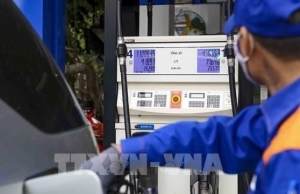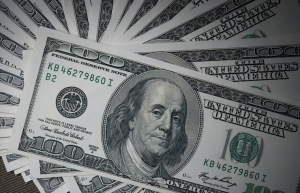Vietnam acts to ensure stability of oil in face of global squeeze
The Ministry of Industry and Trade’s (MoIT) leadership last week sent a document to its Department of Domestic Markets asking the latter to work with the Ministry of Finance and relevant agencies to “closely follow the developments of the world’s fuel prices, and take the initiative in regulating the fuel prices within its power and in line with the law, and apply solutions to provide sufficient fuel for the economy in all situations, ensuring the benefits of the state, people, and enterprises.”
 |
| Vietnam acts to ensure stability of oil in face of global squeeze, photo Le Toan |
The move came after Prime Minister Pham Minh Chinh ordered the MoIT to combine with ministries and agencies to “closely watch the situations of indispensable items in the market, especially fuel, and find all ways to prevent any disruptions in fuel supplies, and sufficient fuel must be ensured for domestic production and consumption.”
According to the MoIT, the world’s fuel market in the last three months of 2022 will continue facing challenges caused by various geopolitical factors including unpredictable crude oil output from the Organization of the Petroleum Exporting Countries. Last week, it signed up to a cut in output of two million barrels a day, surpassing previous predictions of 1-1.5 million barrels, squeezing supplies in a tight market.
“Thus the fuel prices will continue becoming increasingly complicated, with a high increase continuing, while fuel is the key input for production and consumption. There have been shortages of fuel supplies and increases in production costs which have created big pressure to inflation in Vietnam and affected purchasing power in the country,” the MoIT said in a report released last week.
State-owned oil and gas group PetroVietnam reported that it will continue making efforts in ensuring fuel supplies for the domestic market.
“Regarding the production plans of Nghi Son and Binh Son oil refinery and petrochemical plants in the second half of 2022, these two plants are estimated to produce 3.9 million cubic metres in Q3 – accounting for 72 per cent of the market’s demand, and 4.4 million cu.m in Q4 – occupying 80 per cent of the market’s demand,” PetroVietnam said in a document sent to the MoIT.
“At present, the two plants are operating at full speed. The Binh Son plant is expected to operate at a 105 per cent capacity in the latter half of this year in order to supply fuel for the domestic market,” PetroVietnam said.
The $9.3 billion Nghi Son plant in the north-central province of Thanh Hoa is invested by PetroVietnam (25.1 per cent), Kuwait Petroleum International (35.1 per cent), and the Japanese firms Idemitsui Kosan (35.1 per cent) and Mitsui Chemicals (4.7 per cent).
Meanwhile, Binh Son Refining and Petrochemical JSC is a member unit of PetroVietnam and is responsible for receiving, managing, and operating Dung Quat Oil Refinery in the central province of Quang Ngai. The refinery is a national key project with a total investment of over $3 billion, and a processing capacity of 6.5 million tonnes of crude oil a year.
PetroVietnam also reported that its total revenue in the first nine months is estimated to be over VND587.14 trillion ($25.52 billion), up 59 per cent on-year.
The group exploited 8.15 million tonnes of crude oil, down 1 per cent on-year; and six billion cubic metres of natural gas, up 3 per cent on-year; produced 1.35 million tonnes of nitrate, up 7 per cent, 9.98 million kWh of electricity, down 18 per cent, and 5.15 million tonnes of assorted fuel, up 8 per cent.
Notably, PetroVietnam’s 9-month export turnover totalled over $2.17 billion, up 54 per cent as compared to the same period last year. In which crude oil exports hit 6.34 million tonnes – down 3 per cent, and liquefied petroleum gas exports reached 163,800 tonnes – down 19 per cent.
The group’s 9-month inventory also saw an on-year reduction, including liquefied petroleum gas (79 per cent), assorted fuel (48 per cent), and polypropylene (50 per cent).
According to the General Statistics Office, Vietnam’s revenue from crude oil exports in September is estimated to be $304.35 million, raising a 9-month figure to about $2.61 billion, doubling the annual estimates and up 103.5 per cent as compared to the same period last year.
Nguyen Hoai Nam, deputy general secretary of the Vietnam Association of Seafood Exporters and Producers, said that stability in fuel prices will help thousands of fishery businesses in the country to stay afloat and improve competitiveness.
“Despite some recent reductions of fuel prices, the fishery industry is still facing massive difficulties including a hike in transportation costs and fuel prices, and this has been burdening enterprises,” Nam said. “High fuel prices have been causing big pressures to ship owners. Each trip offshore to fish would need about VND300 million (over $13,000) for a ship.”
Each time the fuel price is increased, the ship’s operational costs will escalate by 20-30 per cent on average as the ship will need fuel, ice to freeze fish, drinking water, and foodstuffs, among many others, Nam added. “Also, the increase in fuel prices has also caused a 15-20 per cent rise in the transportation costs for automobiles domestically.”
Such costs are even increased more strongly for goods transported by sea, according to Nam. For instance, the transportation cost increased from $4,000 to $18,000 per 40-feet container to the eastern United States in the first months of this year, before reducing to $16,400 in June.
It is expected that Vietnam’s aquatic export turnover will exceed $10 billion this year, up about 12-15 per cent as compared to last year. The figure in the first nine months of 2022 is estimated to hit over $8.5 billion, up 38 per cent on-year thanks to growing demands for Vietnamese aquatic products.
 | Petrol prices down in latest adjustment Retail prices of oil and petrol dropped from 3pm on October 3 following the latest adjustment by the Ministry of Industry and Trade, and the Ministry of Finance. |
 | OPEC+ expected to slash oil output Major oil producers led by Saudi Arabia and Russia were set to meet Wednesday as reports said they were mulling an output cut of up to two million barrels per day in a bid to prop up slumping prices. |
 | Oil jumps but dollar bruised on US data Oil prices jumped Monday on expectations of an OPEC output cut, while weak US data sent stocks higher amid rising hopes central banks may be able to ease off interest rate hikes. |
What the stars mean:
★ Poor ★ ★ Promising ★★★ Good ★★★★ Very good ★★★★★ Exceptional
Related Contents
Latest News
More News
- Global partnerships key to Vietnam’s IFC development (December 26, 2025 | 16:18)
- Vingroup pulls out of bid to invest in North-South high-speed railway (December 26, 2025 | 11:42)
- Strengthening supply chains through trade promotions and customs reform (December 24, 2025 | 14:00)
- PM orders investment model for North–South high-speed rail (December 22, 2025 | 17:43)
- LS Eco Energy to invest in Vietnam rare earth sector (December 22, 2025 | 17:31)
- Government moves to establish International Financial Centre (December 21, 2025 | 21:00)
- Vietnam's IFC to target global investment flows (December 21, 2025 | 18:00)
- Two national hospitals expand capacity with new facilities (December 20, 2025 | 09:00)
- Ha Tinh breaks ground on major Vingroup industrial and energy projects (December 19, 2025 | 18:24)
- EVN launches major power infrastructure projects nationwide (December 19, 2025 | 18:17)

 Tag:
Tag:





















 Mobile Version
Mobile Version